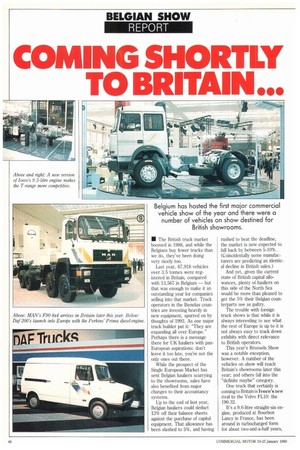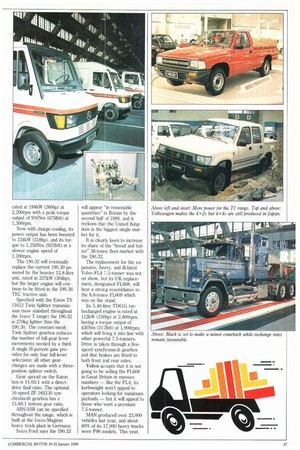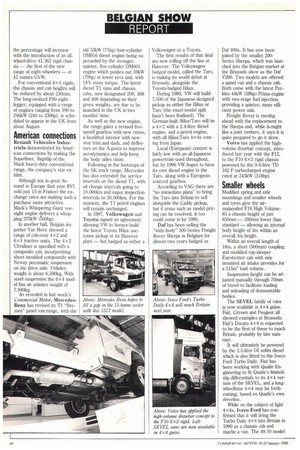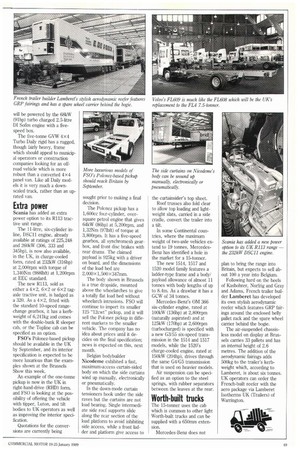COMING SHORTLY TO BRITAIN...
Page 48

Page 49

Page 50

Page 51

If you've noticed an error in this article please click here to report it so we can fix it.
• The British truck market boomed in 1988, and while the Belgians buy fewer trucks than we do, they've been doing very nicely too.
Last year, 67,918 vehicles over 3.5 tonnes were registered in Britain, compared with 13,567 in Belgium — but that was enough to make it an outstanding year for companies selling into that market. Truck operators in the Benelux countries are investing heavily in new equipment, spurred on by thoughts of 1992. As one major truck builder put it: "They are expanding all over Europe." Perhaps there is a message there for UK hauliers with panEuropean aspirations: don't leave it too late, you're not the only ones out there.
While the prospect of the Single European Market has sent Belgian hauliers scurrying to the showrooms, sales have also benefited from major changes to their accountancy systems.
Up to the end of last year, Belgian hauliers could deduct 13% off their balance sheets against the purchase of capital equipment. That allowance has been slashed to 5%, and having rushed to beat the deadline, the market is now expected to fall back by between 5-10%. (Coincidentally some manufacturers are predicting an identical decline in British sales.) And yet, given the current state of British capital allowances, plenty of hauliers on this side of the North Sea would be more than pleased to get the 5% their Belgian counterparts see as paltry.
The trouble with foreign truck shows is that while it is always interesting to see what the rest of Europe is up to it is not always easy to track down exhibits with direct relevance to British operators.
This year's Brussels Show was a notable exception, however. A number of the vehicles on show will reach Britain's showrooms later this year; and others fall into the "definite maybe" category.
One truck that certainly is coming to Britain is Iveco's new rival to the Volvo FL10: the 190.32.
It's a 9.6-litre straight-six engine, produced at Bourbon Lancy in France, has been around in turbocharged form for about two-and-a-half years, rated at 194kW (260hp) at 2,200rpm with a peak torque output of 916Nm (675Ibft) at 1,30Orpm.
Now with charge-cooling, its power output has been boosted to 234kW (318hp), and its torque to 1,250Nm (9211bft) at a slower engine speed of 1,20Orpm.
The 190.32 will eventually replace the current 190.30 powered by the heavier 13.8-litre unit, rated at 227kW (304hp), but the larger env* will continue to be fitted in the 190.36 TEC tractive unit.
Specified with the Eaton TS 11612 Twin Splitter transmission (now standard throughout the Iveco T range) the 190.32 is 270kg lighter than the 190.30. The constant-mesh Twin Splitter gearbox reduces the number of full-gear lever movements needed by a third. A single H-pattern gate provides for only four full-lever selections: all other gearchanges are made with a threeposition splitter switch.
Gear spread on the Eaton box is 14.05:1 with a directdrive final ratio. The optional 16-speed ZF 165130 synchromesh gearbox has a 13.68:1 bottom gear ratio.
ABS/ASR can be specified throughout the range, which is built at the Iveco-Magirus heavy truck plant in Germany.
Iveco Ford says the 190.32 will appear in reasonable quantities" in Britain by the second half of 1989, and it reckons that the United Kingdom is the biggest single market for it.
It is clearly keen to increase its share of the "bread and butter" 38-tonne fleet market with the 190.32.
The replacement for the expensive, heavy, and ill-fated Volvo FL4 7.5-tonner was not on show, but its UK replacement, designated FL608, will bear a strong resemblance to the 8.6-tonne FL609 which was on the stand.
Its 5.48-litre TD61G turbocharged engine is rated at 112kW (150hp) at 2,800rpm, having a torque output of 430Nm (3171bft) at 1,900rpm, which will bring it into line with other powerful 7.5-tonners. Drive is taken through a fivespeed synchromesh gearbox and disc brakes are fitted to both front and rear axles.
Volvo accepts that it is not going to be selling the FL608 in Great Britain in massive numbers — like the FL4, its kerbweight won't appeal to operators looking for maximum payloads — but it will appeal to those who want a premium 7. 5-tonner.
MAN produced over 23,000 vehicles last year, and about 80% of its 17,000 heavy trucks were F90 models. This year, the percentage will increase with the introduction of an allwheel-drive 41.361 rigid chassis — the first of the new range of eight-wheelers — at 41 tonnes GVW.
For conventional 8x4 rigids, the chassis and cab heights will be reduced by about 230mm. The long-awaited F90 eightlegger, equipped with a range of engines ranging from 196 to 246kW (240 to 330hp), is scheduled to appear in the UK from about August.
American connections
Renault Vehicules Industriels demonstrated its American connections by making the Superliner, flagship of the Mack heavy-duty conventional range, the company's star exhibit.
Although not in great demand in Europe (last year RVI sold just 15 in France) the exchange rates are making such a purchase more attractive. Mack's Whispering Giant veeeight engine delivers a whopping 373kW (00hp).
In another hall, Belgian importer Van Hove showed a range of cab-over 4x2 and 6x4 tractive units. The 4x2 Ultraliner is specified with a composite cab, incorporating sheet moulded compounds with Neway pneumatic suspension on the drive axle. Unladen weight is about 6,590kg. With steel suspension the 6x4 model has an unladen weight of 7,940kg.
As revealed in last week's Commercial Motor, MercedesBenz has revised its Ti "Bremen" panel van range, with the old 53kW (71hp) four-cylinder 0M616 diesel engine being superseded by the stronger, quieter, five-cylinder 0M601 engine which pushes out 59kW (79hp) at lower revs and, with 14% more torque. The latest diesel Ti vans and chassis cabs, now designated 208, 308 and 408 depending on their gross weights, are due to be launched in the UK in two months' time.
As well as the new engine, the range gains a revised fivespeed gearbox with new ratios, a facelifted interior with new seat trim and dash, and deflectors on the A-posts to improve aerodynamics and help keep the body sides clean.
Following in the footsteps of the SK truck range, Mercedes has also extended the service intervals on the diesel Ti, with oil change intervals going to 10,000km and major inspection intervals to 30,000km. For the moment, the T1 petrol engines will remain unchanged.
In 1987, Volkswagen and Toyota signed an agreement allowing VW to licence-build the latest Toyota Hilux onetonne pickup at its Hanover plant — but badged as either a
Volkswagen or a Toyota.
The first results of that deal are now rolling off the line at Hanover. The Volkswagenbadged model, called the Taro, is making its world debut at Brussels, alongside the Toyota-badged During 1989, VW will build 7,500 of the Japanese-designed pickup as either the Hilux or Taro (the exact model split hasn't been finalised). The German-built Hilux/Taro will be a 4x2 with a 2.4-litre diesel engine, and a petrol engine, with all Hilux/Taro 4x4s coming from Japan.
Local (European) content is fairly low with an all-Japanese powertrain used throughout, but by 1990 VW hopes to have its own diesel engine in the Tato, along with a Europeansourced gearbox.
According to VAG there are "no immediate plans" to bring the Taro into Britain to sell alongside the Caddy pickup, but if areas such as model pricing can be resolved, it too could come in by 1990.
Daf has been selling the "wide-body" 300-Series Freight Rover Sherpa in Belgium for almost two years badged as
Daf 400s. It has now been joined by the smaller 200Series Sherpa, which was launched into the Belgian market at the Brussels show as the Daf V200. Two models are offered: a panel van and a chassis cab. Both come with the latest Perkins 44kW (59hp) Prima engine with two-stage fuel injection, providing a quieter, more efficient power unit.
Freight Rover is moving ahead with the replacement to the Sherpa and, while iti might like a joint venture, it says it is quite prepared to go it alone.
Volvo has applied the highvolume drawbar concept, introduced last year with the F12, to the F10 6x2 rigid chassis powered by the 9.6-litre TD 102 F turbocharged engine rated at 243kW (318hp).
Smaller wheels
Modified spring and axle mountings and smaller wheels and tyres give the airsuspended F10 High Volume85 a chassis height of just 850mm — 200mm lower than standard — allowing an internal body height of 3m within an overall 4m height.
Within an overall length of 18m, a short (500mm) coupling and modified top-sleeper Eurotrotter cab with side mounted air intake provides for a 115m3 load volume.
Suspension height can be adjusted manually through 70mm of travel to facilitate loading and unloading of demountable bodies.
The SEVEL family of vans is now available in 4x4 guise. Fiat, Citroen and Peugeot all showed examples at Brussels; Fiat's Ducato 4x4 is expected to be the first of these to reach Britain, probably by late summer.
It will ultimately be powered by the 2.5-litre DI sofmi diesel which is also fitted to the lveco Ford Turbo Daily. Fiat has been working with Quaife Engineering to fit Quaife's limitedslip differentials to its 4x4 version of the SEVEL, and a longwheelbase 4x4 may be forthcoming, based on Quaife's own driveline.
While on the subject of light 4x4s, lveco Ford has confirmed that it will bring the Turbo Daily 4x4 into Britain in 1990 as a chassis cab and maybe a van. The 49.10 model
will be powered by the 68kW (91hp) turbo charged 2.5-litre DI Sofim engine with a fivespeed box.
The five-tonne GVW 4x4 Turbo Daily rigid has a rugged, though fairly heavy, frame which should appeal to municipal operators or construction companies looking for an offroad vehicle which is more robust than a converted 4 x4 panel van. Like all Daily models it is very much a downscaled truck, rather than an uprated van.
Extra power
Scania has added an extra power option to its R113 tractive unit range.
The 11-litre, six-cylinder inline, DSC11 engine, already available at ratings of 225,248 and 260kW (306, 333 and 345hp), is now also available, in the UK, in charge-cooled form, rated at 232kW (316hp) at 2,000rpm with torque of 1,340Nm (9881bft) at 1,200rpm at EEC standard.
The new R113, sold as either a 4x2, 6x2 or 6x2 tagaxle tractive unit, is badged as a 320. As a 4x2, fitted with the standard 10-speed rangechange gearbox, it has a kerbweight of 6,241kg and comes with the double-bunk R sleeper cab, or the Topline cab can be specified as an option.
FSO's Polonez-based pickup should be available in the UK by September, and its interior specification is expected to be more luxurious than the examples shown at the Brussels Show this week.
An example of the one-tonne pickup is now in the UK in right-hand-drive (RHD) form, and FS() is looking at the possibility of offering the vehicle with tipper, Luton, and tilt bodies to UK operators as well as improving the interior specification.
Quotations for the conversions are currently being sought prior to making a final decision.
The Polonez pickup has a 1,600cc four-cylinder, oversquare petrol engine that gives 64kW (86hp) at 5,200rpm, and 1,32Nm (97Ibft) of torque at 3,800rpm. It has a five-speed gearbox, all synchromesh gearbox, and front disc brakes with rear drums. The claimed payload is 925kg with a driver on board, and the dimensions of the load bed are 2,000x 1, 500x 347mm.
The body shown in Brussels is a true dropside, mounted above the wheelarches to give a totally flat load bed without wheelarch intrusions. FS0 will continue to import its smaller 125 "12cwt" pickup, and it will sell the Pokmez pickup in different markets to the smaller vehicle. The company has no idea about prices until it decides on the final specification; news is expected on this, next month.
Belgian bodybuilder Nicodeme exhibited a fast, maximum-access curtain-sided body on which the side curtains wind up manually, electronically or pneumatically.
In the down-mode curtain tensioners hook under the side raves but the curtains are not load bearing. Single intermediate side roof supports slide along the rear section of the load platform to avoid inhibiting side access, while a front ladder and platform give access to the curtainsider's top sheet.
Roof trusses also fold clear to allow top loading and lightweight slats, carried in a side cradle, convert the trailer into a tilt.
In some Continental countries, where the maximum weight of two-axle vehicles extend to 19 tonnes, MercedesBenz has identified a hole in the market for a 15-tonner.
The new 1514, 1517 and 1520 model family features a ladder-type frame and a body/ payload allowance of almost 11 tonnes with body lengths of up to 8.4m. As a drawbar it has a GCW of 34 tonnes.
Mercedes-Benz's OM 366 six-cylinder engine, rated at 100kW (136hp) at 2,800rpm (naturally aspirated) and at 125kW (170hp) at 2,600rpm (turbocharged) is specified with a new G3/55 six-speed transmission in the 1514 and 1517 models, while the 1520's charge-cooled engine, rated at 150kW (204hp), drives through the same G4/G5 transmission that is used on heavier models.
Air suspension can be specified as an option to the steel springs, with rubber separators between the leaves at the rear.
Worth-built trucks
The 15-tonner uses the cab which is common to other light Worth-built trucks and can be supplied with a 650mm extension.
Mercedes-Benz does not plan to bring the range into Britain, but expects to sell about 100 a year into Belgium.
Following hard on the heels of Kasbohrer, Norfrig and Gray and Adams, French trailer builder Lamberet has developed its own stylish aerodynamic reefer which features GRP fairings around the enclosed belly pallet rack and the spare wheel carrier behind the bogie.
The air-suspended chassisless model on display at Brussels carries 33 pallets and has an internal height of 2.6 metres. The addition of the aerodynamic fairings adds 500kg to the trailer's kerbweight which, according to Lamberet, is about six tonnes. UK operators can order the French-built reefer with the aero package via Lamberet Isotherms UK (Trailers) of Warrington.
































































































